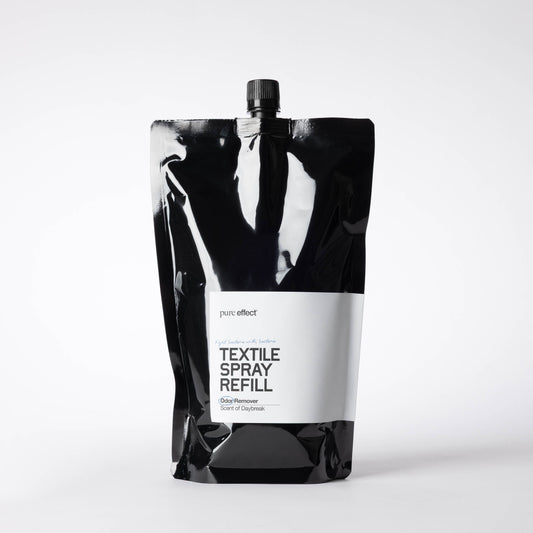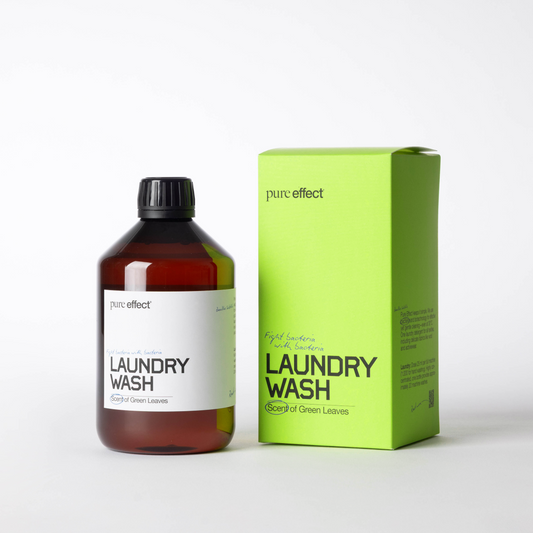
The dirty story of laundry
Why do we wash and what is the real cost in money, energy and wear-and-tear on our clothes? We've dug deep into the subject and found that there are huge benefits in reducing our laundry washing on a global scale. And with new behaviour, biotechnology and odour-removing bacteria … we can.
HANG, SPRAY, REPEAT
On average, my family of four will go through four laundry cycles per week. I challenged them that over a period of a month, they were to consciously consider each item’s needs at the end of the day’s wear. Where possible, the item would be hung up and sprayed with Pure Effect’s Clothing & Shoe Mist, instead of automatically throwing it into the laundry basket. The results were amazing. We reduced our washing by 25% and to date the new behavioural pattern lingers on.
CREATURES OF HABIT AND FEAR
A hundred years ago, people washed their clothes for hygienic reasons by airing, scrubbing, and boiling them to get rid of the nasty dirt, lice and harmful bacteria in order to prevent diseases like cholera and typhus. Back then, the fear of germs was justified. Today, laundry is more about washing clothes for the sake of smelling good - or the fear of smelling bad. When you’re tidying up a room, clothes land up in the laundry basket more to get them out of the way than anything else. Additionally, humans are creatures of habit and seem quite anxious about what people will think of them. Taking freshly laundered clothes out of one’s wardrobe every day can feel like a simple guarantee of fitting in. But our obsession with hygiene and laundry comes at a cost - in energy, water, fibres, detergents, and emissions. So what does our washing obsession really cost humans and our planet?
YOUR LAUNDRY FOOTPRINT
- Energy - The washing machine is one of the home appliances which uses a great deal of electricity. Take a 4 kg load of laundry. When washed at 60 degrees, 1.4 kWh is used, while at 40 degrees it uses 0.6 kWh. The tumble dryer on the other hand requires three times as much energy as a washing machine.
- Water - One wash load in a laundry machine uses about 50 litres of water. That means by reducing a family of four’s laundry requirements by 25% (from four to three loads a week), they would be saving 2600 litres per year.
- Emissions - Every time you wash a synthetic garment, around 1900 pieces of micro-plastics are released into the water and risk the eventuality of landing up in the sea and waterways. It is advisable to wash these in cooler temperatures as it is the hot water that causes the release of micro-plastics. Wash synthetic clothes less often and for shorter periods of time. (See www.aktuellhallbarhet.com). The wear and tear on fabrics goes for all textiles - just with different emissions.
- Fibre - Washing clothes involves rubbing, folding, and tearing the fibres in the garments, which of course eventually cause them to break. In 2018, 85% of all the textile waste in the US landed up in landfills (United States Environmental Protection Agency).
- Detergents contain chemicals in some form or another that can pollute the environment. In order to get clothes clean, we become part of a chain of dirty emissions. The production, transport and consumption of detergents also leads to a chain of carbon emissions.
MAKE IT LAST
“Buy less, choose well, make it last” is a famous quote from Vivienne Westwood. This is of particular significance and critical for responsible fashion, as for every extra season we use a garment, we reduce its carbon and water footprint. And when talking about choosing well and caring for your clothes: consider an ordinary t-shirt. On average, it is used 30 times before it is thrown away. If we double the active life of the t-shirt to 60 uses before discarding it, we can reduce the carbon footprint by as much as 49% (Mistra Future Fashion report 2019)! We can talk about this for days, months and years ….. and we will. But to summarise: if you want to reduce your carbon footprint, be smart when it comes to taking care of your clothes. Avoid laundry when you can. Spray with Pure Effect mists to remove odour and stains. And together we can reduce global laundry by around 30%. And this will definitely have a big impact on our collective goal for a future worth living in.
___________________
Fashion in figures
The consumption of clothing and footwear is expected to increase by 63% by 2030, i.e. from 62 million tons now to 102 million tons then. (European Environment Agency)
The global textile production has almost doubled, between 2000 and 2015 (Ellen MacArthur Foundation).
In 2020, EU citizens bought 6,6 million tons of clothing and footwear (14,8 kg per person)
85% of all the textile waste in the US in 2018 ended up in landfills (United States Environmental Protection Agency)




